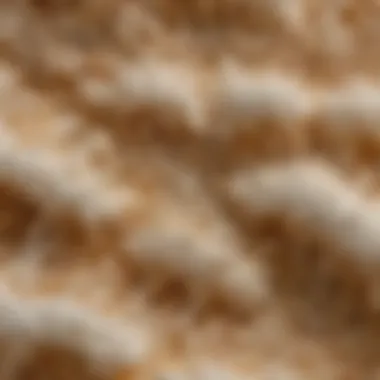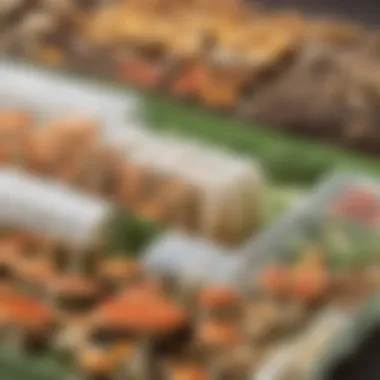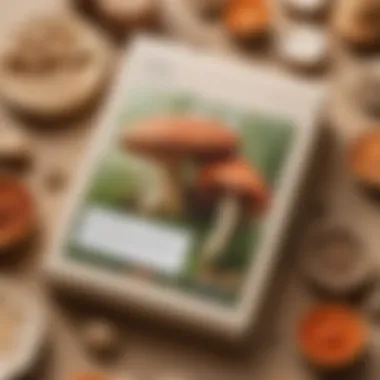Fungi Packaging: A Breakthrough in Sustainable Materials


Intro
As we face global challenges such as waste management and environmental degradation, innovative solutions are needed now more than ever. One surprising yet remarkable solution is found in the realm of fungi, specifically in their application in packaging materials. Fungi can provide an eco-friendly alternative to plastic, helping to mitigate pollution and engage with sustainable practices. Understanding how fungi can be turned into packaging opens a dialogue about our resource usage and its implications for future generations.
Science Fun Facts
Delving into the world of fungi reveals some astonishing properties and facts about these remarkable organisms. Here are some known aspects of fungi and their potential in sustainable packaging:
- Adaptation: Fungi are capable of breaking down organic materials, suggesting a natural method for recycling waste. They can thrive in varied environments, which helps them maintain their life cycle.
- Rapid Growth: Certain fungi species can grow quite rapidly, even within a matter of days. This fast growth means large quantities can yield significant material in a short time.
- Biodegradability: Fungi packaging is designed to decompose, leaving no harmful residue unlike most conventional plastics. This property addresses lingering plastic concerns exacerbated by global trends in littering and disposal.
In the context of packaging, understanding a few trivia and records surrounding fungi solidifies their importance in scientific exploration. For example, the largest living organism on the planet is a mushroom, and it spans over 2,385 acres in Oregon! The interconnected systems of mycelium can provide strength and durability for various packaging purposes while being lightweight.
Switching gears, what if you ever stumbled upon unique features of fungi in food packaging? This educated guess can lead you to hunt valuable educational resources or engage with ideas about mycelium not just possible to utilize in packaging but throughout numerous applications. Ponder this; how do fungi decompose organic matter in nature? The answer expresses a cycle of renewal vital to environmental health.
As science progresses, knowledgeable experimentation and research can reveal fun and valuable insights, potentially easing the link between our ecological concerns and creative, biodegradable solutions.
In the subsequent sections, we will explore various scientific concepts surrounding fungi, their property specifics in creating sustainable packages, critical production processes managing these organic materials, and their far-reaching applications. The discussion aims to enlighten elementary students, parents, and others interested in biodegradable technology as fertile ground for future endeavors.
Prolusion to Fungi as Packaging Material
Fungi represent a fascinating frontier in the realm of packaging materials. With increasing concern over environmental sustainability, these organisms offer a compelling alternative to traditional materials. This section delves into what fungi are and why their potential in packaging is significant.
What Are Fungi?
Fungi are a diverse group of organisms, distinct from plants and animals. They encompass yeasts, molds, and mushrooms. Unlike plants, fungi do not photosynthesize. Instead, they absorb nutrients from their environment. This ability allows them to thrive in various ecosystems, breaking down complex organic materials.
Fungi play essential ecological roles. They decompose organic matter and recycle nutrients. This natural process contributes to soil health and biodiversity. The unique structure of fungi, particularly their mycelium, is crucial for their function. Mycelium is a network of thread-like structures that form when fungi grow. It is this network that is starting to be utilized in various sustainable applications, including packaging materials.
Importance of Sustainable Packaging
The need for sustainable packaging is more urgent than ever. Conventional materials, such as plastics, are environmentally harmful. They take long to decompose and often end up in landfills or oceans. This leads to pollution and carbon emissions, significantly impacting our ecosystem.
Fungi-based packaging presents a solution to these problems. Fungal materials are biodegradable and compostable. Unlike traditional plastics, which last hundreds of years, fungal packaging can break down into organic matter in a few weeks. By choosing fungi-based materials, companies can reduce their environmental footprint. This innovation encourages a shift towards circular economy practices, where waste is minimized, and materials are reused effectively.
In summary, exploring fungi as a packaging material is crucial in the quest for sustainable solutions. Understanding these topics can inspire further innovation and highlight the significance of fungi in materials science.
Fungi-based packaging sets the stage for a revolutionary movement in reducing plastic waste and embracing environmentally friendly materials.
Properties of Fungal Materials
The properties of fungal materials play a critical role in understanding their application as sustainable packaging solutions. These properties are derived from the unique composition of fungi and can make a dramatic impact in reducing environmental footprint compared to traditional packaging. This section explains the fundamental aspects of three essential properties: biodegradability, strength and durability, and thermal insulation. Each contributes decisively to the viability of fungi-based materials. Moreover, recognizing these characteristics may lead to innovative applications in various industries.
Biodegradability
Biodegradability is a strong-selling point for fungi packaging. Traditional plastic materials can take hundreds of years to decompose, leading to significant environmental problems. Conversely, fungal materials break down naturally within a much shorter time frame, oftentimes within weeks or months. This decomposition occurs because fungi contain natural enzymes that efficiently break down organic matter. As a result, fungal packaging reduces landfill waste significantly.
Mercy to its biodegradability, fungi offer a promising alternative to plastic, helping in avoiding microplastics from entering ecosystems. When consumers dispose of fungal packaging, it returns safe nutrients to the soil.
“Using biodegradable materials like fungal packing combines ecological safety with innovative design.”
In addition to reducing waste, this property supports the circular economy, where products are designed for reuse and recycling rather than disposal. This highlights how essential biodegradable materials are in mitigating the adverse effects of indefinite waste.


Strength and Durability
Fungal materials have exceptional strength and durability, making them suitable for various packaging needs. When treated correctly, these materials exhibit a robust structural integrity. Fungal packaging can withstand considerable amounts of pressure without collapsing, comparable to some conventional materials like Styrofoam. Such strength ensures that products remain protected during shipping and transit.
Their durability does not imply that they are forever lasting. The life of fungi materials remains remarkably shorter compared to synthetic options but suitable for single-use or short-duration purposes. This functional durability ensures they encapsulate the benefits of delivering strength where required, while maintaining sustainability.
As industries lean toward sustainable products, the balance of strength, usability, and eco-friendliness becomes crucial.
Thermal Insulation
Numerous fungi species possess natural insulative properties. This ability allows them to resist heat or cold transfer, which can be vital for certain types of packaging. Food packaging, for instance, benefits significantly as it may help maintain temperature, especially for perishable items. When hot or cold products need insulation, packaging materials that efficiently regulate temperature can preserve freshness and quality.
Using fungal materials for insulation relies not only on their ecological aspects but also on the performance needed by numerous sectors. Because fungi have low thermal conductivities, they can act effectively as thermal barriers, potentially outperforming traditional insulative materials.
By integrating these properties into packaging designs, manufacturers can improve efficiency, accomplish ecological responsibility, and engage in meaningful sustainable practices. Fungal materials carry an intrinsic promise in matching functionality with environmental care. Understanding and advocating these properties paves the way for broader acceptance and possibly wider use in various applications.
Production Process of Fungal Packaging
The production process of fungal packaging is essential in understanding its potential as a sustainable alternative. By looking closely at this process, we can identify specific elements that make it advantageous in addressing environmental challenges. Additionally, by comprehending its steps, we gain insights into its practicality in replacing conventional packaging materials.
Cultivation Techniques
Cultivating fungi for packaging uses methods that balance health, efficiency, and growth. First, suitable substrates are identified. These can range from agricultural waste like straw, sawdust, and corn husks. It's important these materials are eco-friendly. Once the right substrate is selected, the fungi, typically mycelium, is introduced. Mycelium is the vegetative part of fungi and will interlace with the substrate, forming a dense network. This growth requires conditions like moisture, warmth, and darkness. By providing optimal conditions, cultivators can maximize growth and reduce waste.
Moreover, different species of fungi are chosen based on their particular properties. For instance, some mycelium strains have faster growth rates, while others exhibit superior bonding capabilities. This diversity allows for the customization of packaging products for various industries.
Molding and Shaping
Once fungal material grows sufficiently, it morphs into a malleable form ready for molding and shaping. This aspect is vital, as it enables the creation of specific items tailored to individual consumer needs. The mycelium-infused substrate can be packed into molds that define the ultimate shape of the packaging product, whether it's containers, padding, or protective casings.
Molding technologies mimic techniques found in traditional packaging production. Utilizing heat and pressure, the fungal material can compact and solidify, creating robust structures. Notably, because of its shell structure, mycelium resists forces without damaging its contents.
Additionally, this shaping process can utilize residue or other recycling materials with minimal additional energy input. Its lower energy consumption is a significant sustainable benefit compared to conventional plastic molding.
Drying and Finishing
The drying and finishing stage solidifies fungal packaging. This step can dramatically influence overall performance. Fungal products must achieve the right moisture content to ensure durability and effectiveness. Traditional techniques employ heat and airflow to remove excess moisture. This phase can make a difference in final product stability, shelf life, and usability.
Once drying completes, the product undergoes finishing treatments. Surface treatments may include tapering edges or applying sealants. Such measures can also enhance aesthetic appeal and functional efficiency. Natural treatments often favor eco-friendliness, maintaining adherence to the original sustainable mission.
Applications of Fungal Packaging
The applications of fungal packaging are pivotal in understanding its potential impacts on our environment. With regular plastic materials still dominating the market, examining how fungi can substitute these widely used products is essential. This section sheds light on specific use areas of fungal packaging and its benefits.
Food Packaging
Food packaging plays a crucial role in maintaining the quality and safety of edible products. Fungal packaging offers a sustainable alternative to conventional plastic, as it is biodegradable and can help reduce food waste. Unlike traditional packaging, which often ends up in landfills and takes hundreds of years to decompose, fungal materials can disintegrate naturally, enriching the soil with nutrients.
Fungi, produced from agricultural waste, provide sufficient protection to food items. They can keep food fresh for an adequate duration, thanks to their natural insulation properties. This dual ability helps diminish the reliance on synthetic materials that have harmful environmental effects. Moreover, fungal packaging impressively reduces lifecycle emissions, making the whole process eco-friendlier.
The shift to biodegradable food packaging can significantly lower plastic contamination in landfills and oceans.
Consumer Goods Packaging


In the realm of consumer goods, fungi serve to address the sustainability challenges faced by businesses. Everyday products like electronics and cosmetics often come encased in durable plastic to protect them in transportation. By innovating with fungal materials, companies can switch away from traditional plastic, thus demonstrating commitment to environmental stewardship.
Fungi can be molded into custom shapes to fit various products while providing cushioning and protection. These qualities ensure that the items remain intact during shipping, enhancing customer satisfaction. Furthermore, using fungi means diverting waste from landfills because the materials decompose effectively when discarded, making it a smarter choice.
Categories that can benefit from fungal packaging include:
- Personal Care – safer, practical alternatives to traditional packaging.
- Electronics – protective packaging that allows for easier recycling upon disposal.
- Cleaning Products – offering natural solutions that enhance the overall brand image.
Industrial Applications
Beyond food and consumer goods, industry settings can utilize fungal packaging effectively. Many large-scale operations can benefit from its use in heavy-duty applications and bulk packaging. For example, fungi can serve in the shipping of components and materials in manufacturing.
One of the main advantages lies in its ability to handle diverse weight loads while being lightweight itself. This reduces transportation costs, energy usage, and contributes to lower overall carbon footprints. Various industries are taking note of these possibilities, especially in logistics and aggregate handling.
Epilogue on Fungal Packaging Applications
The implementation of fungal packaging across food, consumer goods, and industrial applications reflects a significant step towards sustainable material solutions. As innovation continues, acceptance will likely grow among consumers, fueled by a rising awareness of environmental issues. Understanding these applications provides insights.In addition, it opens dialogue on shifting our packaging principles towards eco-friendlier options. Transitioning to fungal materials not only tackles the plastic problem but also enhances sustainability in packaging across varied sectors. The ongoing research seeks to optimize these approaches further.
Comparative Analysis with Traditional Materials
The analysis of fungal packaging in comparison to traditional materials, such as plastics and styrofoam, is crucial in understanding its potential benefits and drawbacks. Fungal materials showcase characteristics that can directly address the shortcomings of conventional packaging solutions. In this section, we explore cost-effectiveness, environmental impact, and overall performance and versatility.
Cost-Effectiveness
When discussing cost, one must consider not only the material cost but also the long-term financial implications. Fungal packaging sources from mushrooms and mycelium, which grow swiftly and can often utilize waste products from agriculture. This can result in lower production costs.
- Raw Material Utilization: By using agricultural by-products, companies can minimize expenses related to sourcing. For example, instead of relying on petrochemicals that fuel plastic production, the input materials are more sustainable, giving a cost advantage.
- Production Scalability: The scalability of fungal packaging is becoming more feasible. Advances in cultivation technology could reduce costs as operations grow and become more efficient. The increase in production can also lead to decreased prices for consumers.
Playable cost structures may attract more businesses to make swift transitions to using fungi-based packaging, expanding acceptance in the consumer market.
Environmental Impact
Exploring the environmental impact of fungal materials is critical in comparing them with traditional alternatives.
- Biodegradability: Unlike plastic and styrofoam, fungal materials decompose’ naturally in a relatively short time frame. Many fungi packages will return to the earth with minimal residue, while plastics can linger (often for centuries) without breaking down.
- Reduced Landfill Contribution: As consumers increasingly turn away from singular-use plastics, utilizing fungal packaging helps decrease landfill levels. Organizations have striven to advocate for their waste reduction potential, appealing to eco-conscious customers.
- Energy Efficiency in Production: The energy requirement for producing fungal packaging is less The processes and systems needed demand lower energy levels, meaning less fossil fuel consumption compared with traditional plastic options, which generally require massive energy and resources.
Fungal materials create a reciprocating relationship between waste management and sustainable innovations.
Performance and Versatility
Concerning performance, fungal packaging competes favorably with traditional materials in various applications.
- Lightweight Nature: Fungal materials are lightweight, which Texas fit into many supply chains. Their low weight can contribute to reduced shipping costs.
- Customizable: Many manufacturers can mold and adapt fungal packaging shapes and sizes easily, providing companies ability to create unique designs that traditional materials may not accommodate easily.
- Protection: Despite the lightweight nature, mycelium has insulating properties and maintains structural integrity under sudden pressure. For instance, under certain circumstances, it delivers more effective cushioning than plastic alternatives, particularly in consumer goods.
In summary, a thorough comparison of fungal packaging to traditional materials illuminates several distinct advantages. Addressing cost, environmental damage, and usability all help highlight the growing trend toward adopting more sustainable solutions in packaging. These factors play a fundamental role at influencing not only industry shifts but also consumer preferences. Making conscious decisions toward adopting sustainable practices starts with understanding their various forged resenses.
Challenges in Fungal Packaging Production
Fungal packaging presents a fascinating opportunity in sustainable materials science. However, producers face several challenges in adopting this innovative solution. Identifying these challenges is crucial not only for companies looking to implement fungal materials but also for consumers interested in alternative packaging options. This section focuses on scalability, consumer acceptance, and regulatory considerations, all of which play a significant role in the success of fungal packaging.
Scalability
One of the primary challenges in the production of fungi-based packaging is scalability. While small-scale production may demonstrate the effectiveness of these materials, large-scale operations require more than just replicating the process. It involves integrating a consistent supply of fungi, controlling environmental factors, and managed costs contacting manufacturing. Without the ability to efficiently scale production, the widespread adoption of fungal packing remains infeasible. Companies need to ensure that they can produce these materials in sufficient quantities to meet market demands.


Consumer Acceptance
Another hurdle to overcome is consumer acceptance. Public perception plays a critical role in the commercialization of any new product, particularly when it involves food or item safety. Fungal materials might face skepticism from consumers who are unfamiliar with them. Awareness and understanding must be fostered to build trust. Educating consumers about the benefits of fungi as a sustainable option can improve acceptance levels. Familiarization must emphasize safety and real-life implications that directly affect customers.
Regulatory Considerations
Regulatory considerations also shape the fungal packaging landscape. Packaging materials are often subject to strict guidelines on safety, materials, and effectiveness. Although fungal materials demonstrate promising properties, they must go through rigorous assessments and certifications to enter mainstream markets. Regulatory discrepancies among different regions can complicate matters further. Companies should keep these considerations in mind as they move forward to ensure meets all necessary compliance.
Addressing these challenges is vital for progress in the field, making collaborations across various sectors essential.
Future Directions of Fungal Packaging Research
The development of fungal packaging marks a significant segment in the realm of sustainable materials science. Exploring future directions is essential. This not only enhances existing knowledge but also establishes a framework for future innovations. The adaptations in this field can be critical in addressing the mounting plastic crisis:
"Fungal packaging represents a viable alternative that could reshape the way we think about materials and consumption."
Innovative Research Areas
Continued research is essential for growing the possibilities of fungi in packaging. Many areas look promising. For instance, bio-engineering methods can enhance fungal characteristics. This basic option allows fungi to adapt their growth patterns and structural properties. Furthermore, researchers may focus on genetic editing. It can lead to stronger and more resistant types of fungal materials.
Another promising research territory involves blends of fungal material with other substances. This could create composite materials. These materials benefit from the strengths of each component, increase durability, and improve performance in diverse conditions. Additionally, investigating fungi's unique physical properties can shine more light on their uses. These initiatives are however still in relatively early stages, indicating much potential for adept scientists and investigates.
Enhancing Properties of Fungal Materials
Enhancing the qualities of fungal materials is crucial. Researchers aim to improve mechanical properties such as tensile strength and flexibility. When these outstanding features develop forward, demands in packaging shouuld benefit significantly. One specific approach is developing fungi strains that produce more mycelium, which can give it essential reinforcement compared to prior versions.
Another vital area involves exploring fungi's resistance to moisture and temperature. Packaging that endures different environmental factors will deliver better protection and payload efficiency. Whereas currently dominant polymers could Nullify over some uses, fungal packaging could make advancements in areas where traditional materials falter. Addressing such technological advancements can obstruct undue costs and waste over time.
Integrating Technology with Mycology
Technology can take interaction to new heights. Integrating it within fungal research projects brings together expertise from material science and biology. Data analytics can find new efficiencies in growing conditions and ecological footprints for fungal production. Advanced modeling software will predict success rates and speed production in ways that increase competitiveness in global packaging environments.
Novel technologies like 3D printing can also serve uplifting purposes within this field. Through fabrication processes, workable prototypes of fungal materials can be created. Subsequently, entrepreneurs will feel empowered in innovations varying from consumer products to construction.
Building connections shapes substantial understanding as well. Collaboration across areas such as agricultural science, building materials, and biotechnology can prove invaluable. Since diverse fields apply similar rêsearch gaps an integrative route will loaded benefits !
Ongoing exploration feeds hungry conversations about progressive societies learning toward resolution as innovative dismantlers. Watching such evolution can turns old ideas upside down, revealing unforeseen potentials. Highlighting the importance of developing effective research avenues too signifies welcoming exciting transitions not only for packaging but overall sustainability aspirations.
The End
In ending this exploration of fungi as a sustainable packaging material, it is crucial to recognize several key points emphasizing the importance of this topic. The matter of packaging is integral not just in the context of present consumption but wider environmental implications. Fungal packaging can lead to a significant reduction in single-use plastic, a major player in global waste crises.
Summary of Benefits
The benefits of fungi as packaging material are extensive and worthy of attention. Here is a concise list of the most important advantages:
- Biodegradability: Fungal materials naturally decompose without harming the environment, addressing urgency in waste management.
- Low Abcarbon Footprint: The production process for fungal packaging requires less energy than traditional plastic materials, reducing overall emissions.
- Sustainable Sourcing: Fungi can be grown from agricultural byproducts, promoting a circular economy that maximizes resource use.
- Raw Material Versatility: Varieties of fungi demonstrate remarkable adaptability, making fungal packaging suitable for a wide range of products.
These benefits collectively showcase how fungal packaging not only promotes sustainability but also offers practical solutions for businesses and consumers alike.
Call for Awareness and Education
There remains a compelling need to raise awareness about the viability of fungal packaging. This encompasses several perspectives:
- Educational Initiatives: Schools and community organizations should introduce programs designed to educate about fungal properties and sustainable materials.
- Public Outreach: It is necessary for more individuals to learn how choosing biodegradable options, like fungi-based packages, influences environmental wellness.
- Industry Collaboration: Partnerships between educational institutions, businesses, and regulatory bodies can foster innovations in fungal packaging.
By promoting awareness and embracing education on this subject, we can inspire a generation to pursue sustainable innovations. Knowledge in fields like mycology and sustainable technology can engage young learners and encourage a greener future.
Preemptive action can lead us away from environmental collapse only if educated minds seek to turn these ideas into reality.







